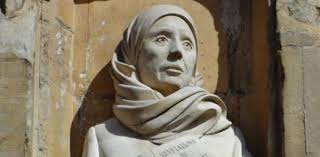The Book of Margery Kempe
translated and edited by Anthony Bale (Oxford World’s Classics, £8.99)
In 1934 an extraordinary literary discovery was made in the library of an Old Catholic family in England. It was a medieval manuscript that had escaped the dissolution of the monasteries. Found in the Derbyshire home of the Butler-Bowdons, it had come there from an older house of theirs, Pleasington New Hall, in Lancashire. But originally it had been in the collections of the Carthusians at Mount Grace Priory, Yorkshire. Annotations in the margins of the book show it was read there with great attention.
The volume was nothing less than the earliest autobiography to be written in English (albeit in Middle English, the English of Chaucer).
Revelation
That was extraordinary enough. But the manuscript, The Book of Margery Kempe, was also a revelation of the religious life, not of a priest or a religious, such as Julian of Norwich (who makes an appearance in the text), but of an ordinary woman who became moved by intense spiritual fervour to remake her life, and to set off on a career of pilgrimage to Jerusalem and to other places in Europe.
The text was not quite unknown, for a very small portion of it had been printed as a small pamphlet by Caxton’s associate Wynken de Worde back in 1501. The owner, William Butler-Bowdon, published a modernisation of the full text in 1934. But this latest version, by an academic at Birkbeck College, London, as well preserving “the forceful narrative voice of the original”, is also equipped with a wide ranging introduction and useful notes, essential for a full understanding.
The book was not written by Margery, who lived on about the cusp of the 15th Century and seems to have been, like most women in the Middle Ages, unable to read or write. She dictated it first to her son, who was not much more literate, and later to priest who completed it for her. Throughout she is described in the third person as “this creature”, which seems odd, but is in keeping with her own piety.
She was an unusual person for she was also a business woman, running a brewery, which failed on her. She then set out on a series of pilgrimages, to Jerusalem, and later to other places.
Her travels to the Holy Land are certainly interesting, but the real heart of the narrative is her religious views, life of prayer, penitence, and self-denial. She visited Julian of Norwich, who is now so widely read, and Julian certified the authenticity of her religious experiences. Though she was the mother of some 14 children, she hardly mentions them. She died about 1440.
To those who have read Julian of Norwich here is an equally important account of medieval piety, but this time focussed on the laity. Not surprisingly Margery Kempe fell foul of the Church authorities. She was falsely accused of being a Lollard, a Bible Christian who used John Wycliffe’s translation of the Bible. This was not true, but she was imprisoned for a time.
Experiences
But we have to recall that then as now, the role of a woman who wished to speak about her visionary experiences and her views on religion, was a difficult one. But her book is now essential reading for anyone wishing to attain a knowledge of the inner life of late medieval Catholicism among the laity.
Could there be one wonders, a similar lost manuscript lurking overlooked in one of our large country houses? It is an intriguing thought.
(The name of the Butler-Bowdon family is also attached to a magnificent late medieval cope embroidered in velvet silk with scenes from the life of the Virgin now in the V & A in London, which is well worth a visit for those moved by the medieval regalia of the Church.)
[Also available is an earlier edition of Margery Kempe’s book from 1985, translated and edited by B. A. Windeatt in the Penguin Classics series at £4.99].


 Peter Costello
Peter Costello Margery Kempe
Margery Kempe